This past Christmas, Robbert gifted me a museum card that gives me access to 400 museums across the country. I’m over the moon with it and can’t wait to visit as many museums as I can, starting ASAP.
I love looking at art and spending hours stolling through dimly lit exposition rooms. However, being who I am, I can’t help but take special notice of the hairstyle of every subject of every painting. It’s usually the first thing I notice, and every now and then, that hairstyle is worth taking a closer look at.
Paintings are my favourite source of historical hairstyling knowledge. They’re visual, contemporary, detailed, and realistic with just a touch of idealisation (which tells us more about the beauty ideals of the time in itself).
Last week, I headed out to the Rijksmuseum in Amsterdam with my new museum card. I was there a few years ago when I had my last museum card that I needed for an art history course in uni, so I knew there was some good hair to be found at the Rijksmuseum. I took a little notebook with me and jotted down the titles of all the paintings that caught my attention.
As I sat down to write this post, I discovered the Rijksmuseum has an absolutey amazing digital collection of nearly everything they have, both on display and in storage. The digital collection is in a separate interface on their website and you can browse, save and download the artwork or even have it directly printed and delivered to your door. Needless to say I spent a while browsing that as well. I saved a bunch of what I came across onto my Historical Hairstyling Pinterest board, if you fancy having a scroll through that.
In this post I wanted to highlight my favourite hairstyles in the paintings that are currently on display at the Rijksmuseum and I came across on my recent visit there. Let’s get inspired!
Portrait of Alida Christina Assink, Jan Adam Kruseman, 1833
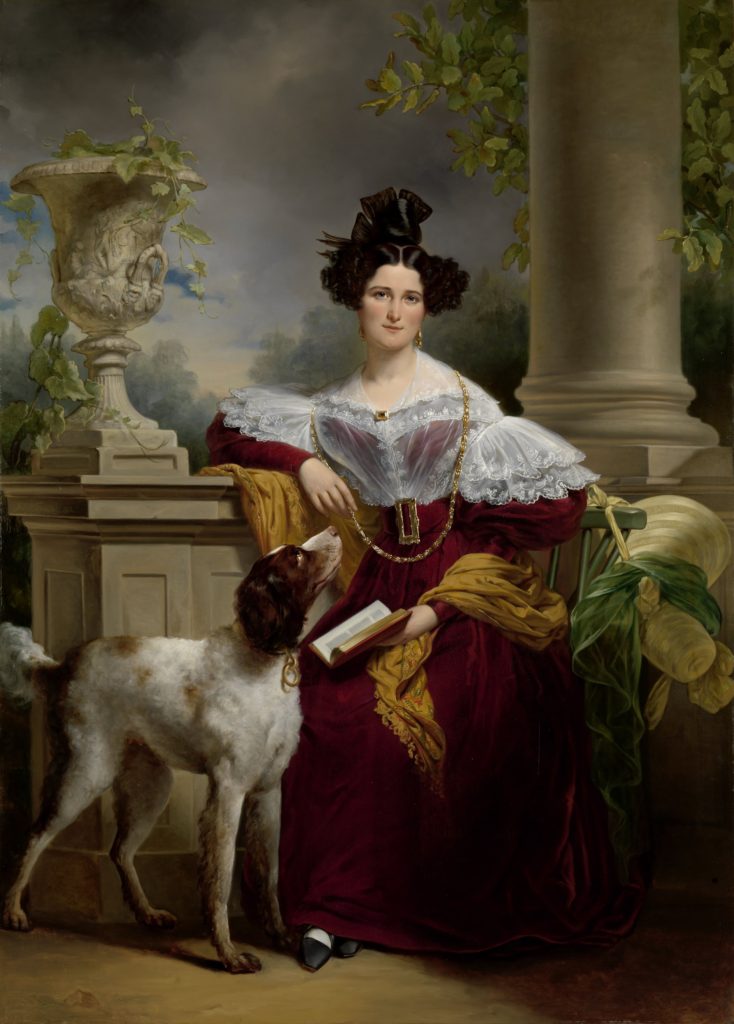
Dressed in the latest fashion, Alida Assink poses here for the society painter Kruseman. The clothing gives her a stylish silhouette: broad shoulders, puff sleeves and a hoop skirt make her waist seem very slim. The large belt buckle further accentuates this. Kruseman admired English portraiture. The rural setting with a hunting dog and a garden vase is derived from English models.
Rijksmuseum
Oh yes, the 1830s. This is one of those time periods in hair history where you can’t help but wonder how on earth this came to be, hahaha! I adore the over-the-top hairstyles with decorations and loops of braids and buns piled on top of the head. Here we see an actually rather subdued daytime hairstyle for the time period, compensated for by a very fabulous dress.
Also; note the straw hat hanging from the chair behind her with the extra high top to accommodate extravagant top knots!
Marie Fargues, the Painter’s Wife, Jean-Etienne Liotard, 1756 – 1758

Liotard was already 54 when he married the 29-yearold Marie Fargues in Amsterdam in 1756. This extraordinary portrait – it is one of Liotard’s largest pastels and necessitated the use of two pieces of vellum – was probably done shortly following their wedding. Liotard chose a composition he had first used in a drawing made in Constantinople and had repeated several times in different contexts: it was, indeed, one of the most famous inventions of his persona as ‘Le peintre turc’.
Rijksmuseum
What a wonderfully natural look for the mid-18th century! This hairstyle looks so feminine, soft and elegant and I love the scarf she used as well. I think this one’s going on my list of hairstyles to recreate, absolutely gorgeous.
Portrait of Isabel Parreño y Arce, Marquesa de Llano, Anton Raphael Mengs, 1771 – 1772
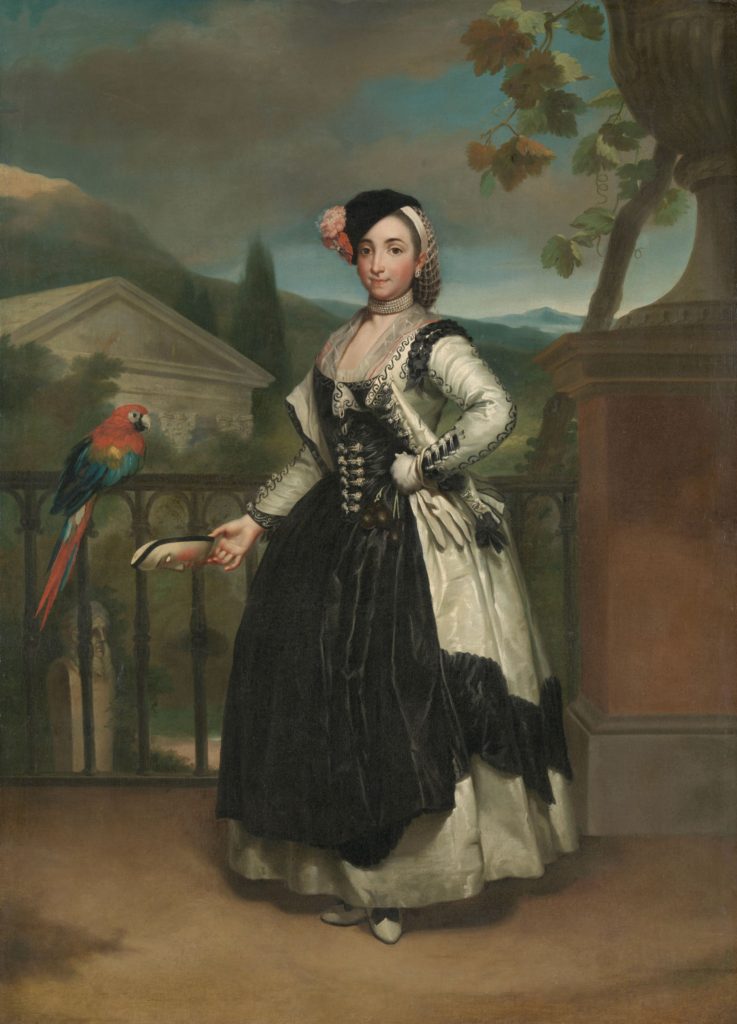
The lady in this painting was the wife of the Spanish ambassador in Parma, Italy. Two versions of this portrait were painted by Mengs –court painter to the Spanish king –together with his assistants. This version was intended for Isabel Parreño’s brother-in-law, the Spanish ambassador to the Netherlands. The marquesa’s Spanish costume had caused a sensa-tion when she wore it during carnival in Parma.
Rijksmuseum
SNOOD! In the wild! And what a gorgeous one, at that. I really wasn’t expecting to run into any snoods at the museum, but after my recent deep-dive into their history and application, I was very excited to see this. Considering the lady is wearing a costume (note the mask in her hand), I wonder whether snoods would have commonly been worn in her time. I must say she rocks it, though.
Mary Magdalene, Carlo Crivelli, c. 1480
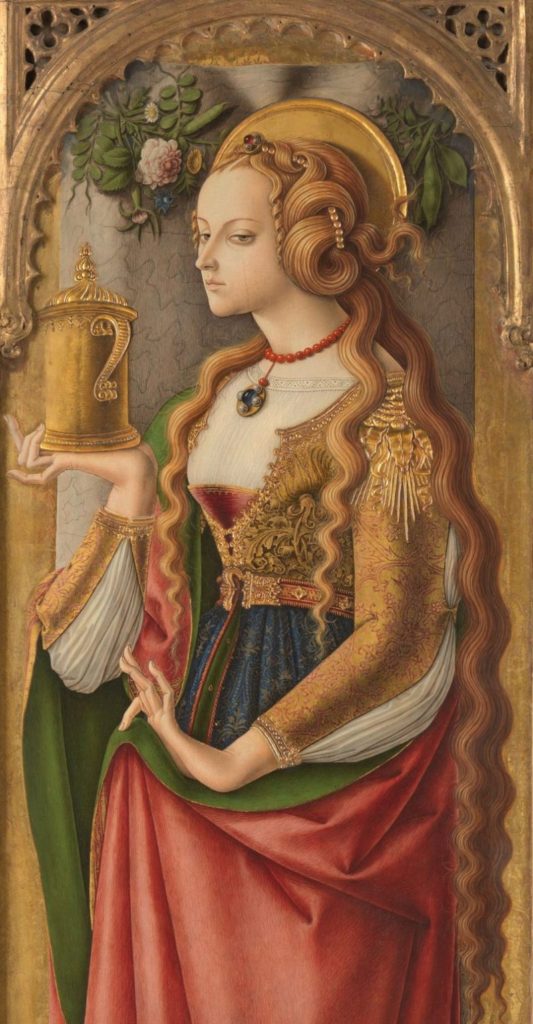
With Carlo Crivelli, the so-called ‘International Gothic’ style experienced its final flowering in Italy. This perfectly preserved panel was painted towards the end of his career. It served as the altarpiece of a provincial church dedicated to Mary Magdalene in the sparsely populated rural area of the Marches where Crivelli lived.
Rijksmuseum
This painting is properly lifesized at 152 cm of height, and believe me when I say it’s impressive. I had to crop it as my blog refused to upload it in full-length, but you can view the full length in my Pinterest board up top, if you wish. This is the oldest painting in my lineup, featuring the most epic and also most stylized hairstyle. One that can’t be recreated, but simply has to be admired in this gold-covered painting. #goals.
Susanna van Collen née Mogge and her daughter, Hermanus Numan, 1776
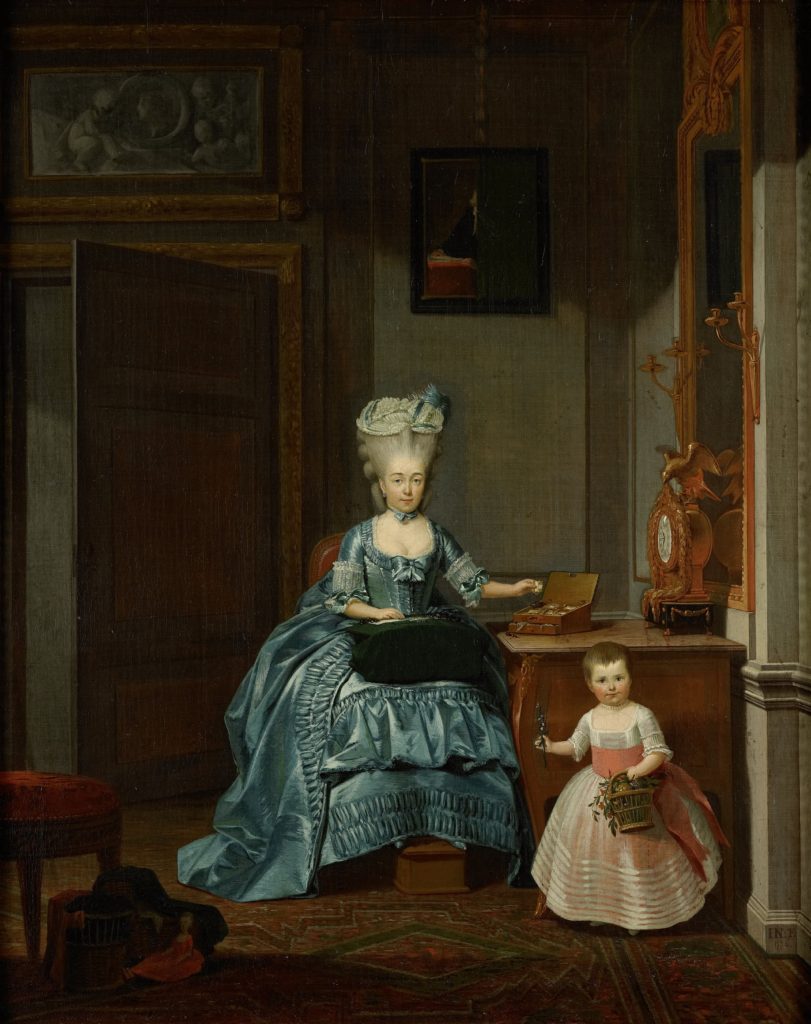
Susanna Mogge is seated in front of a portrait of her deceased husband, Ferdinand van Collen, half-covered by a dark curtain. She is about to be married again, to Hendrik Muilman, a wealthy banker from Amsterdam. Her room is fashioned in the neo-classical style. The curvaceous commode is still rococo in feeling, but its gilded mounts show classical motifs.
Rijksmuseum
What a stylish lady we have here. Typical 1770s with the super vertical, powdered and rolled hair. Seeing this makes me want to wear my hair like this again and if it wasn’t for the damage my hair suffered after the last time, I’d probably do it. Ah, let’s be honest here, I will do it sooner or later anyway.
I love the sheer hight of her hairstyle and the volume in her puffs. Also, if you fancy a giggle, take a closer look at her arms :)
The Music Lesson, Louis Moritz, 1808
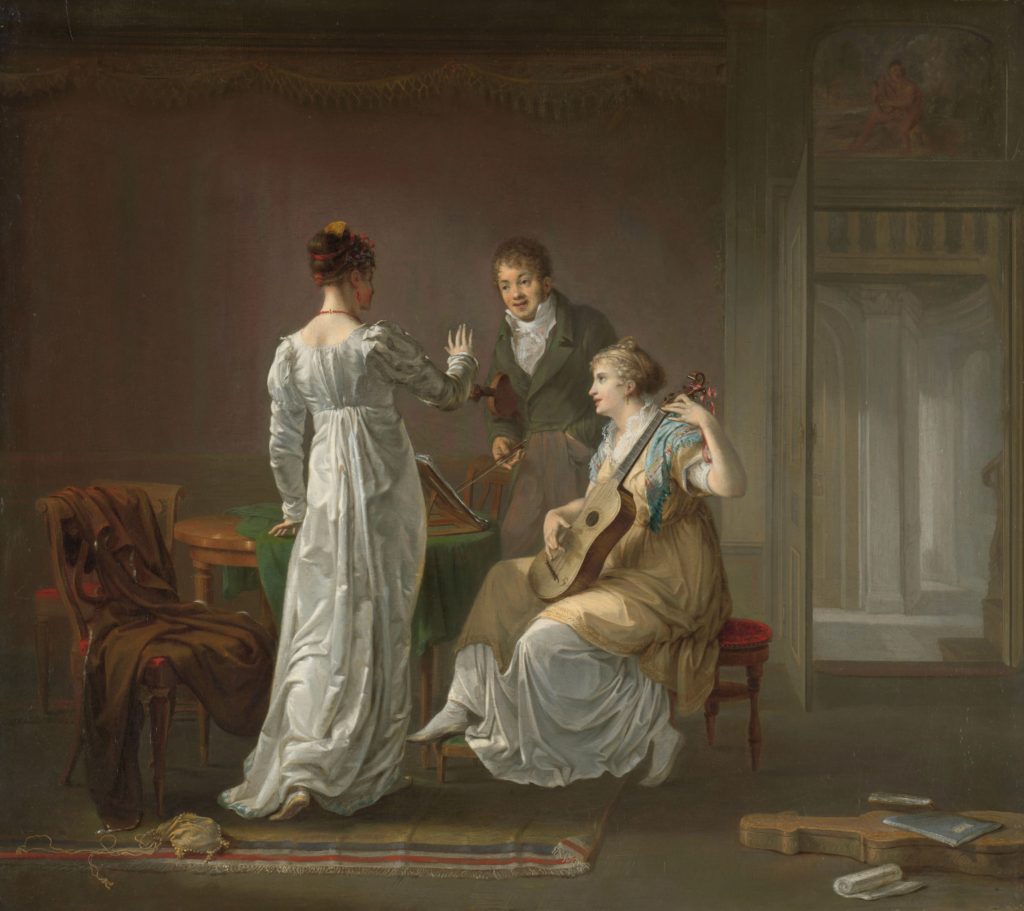
Like The Drawing Lesson, The Music Lesson is set in an interior with a view through to another space. Above the door is a marble relief of the Greek god Apollo playing his lyre. The two women are practising a duet for guitar and voice under the direction of their music teacher. According to tradition, the painter himself served as the model for the teacher.
Rijksmuseum
It’s not often that we’re treated to this good of a look at the back of a hairstyle. A unique occurence that must be noted! We have a beautiful early 19th century classicist hairstyle here with some ribbon and a comb. Very elegant and pretty.
Portrait of a young Woman, with ‘Puck’ the Dog, Thérèse Schwartze, c. 1879 – c. 1885
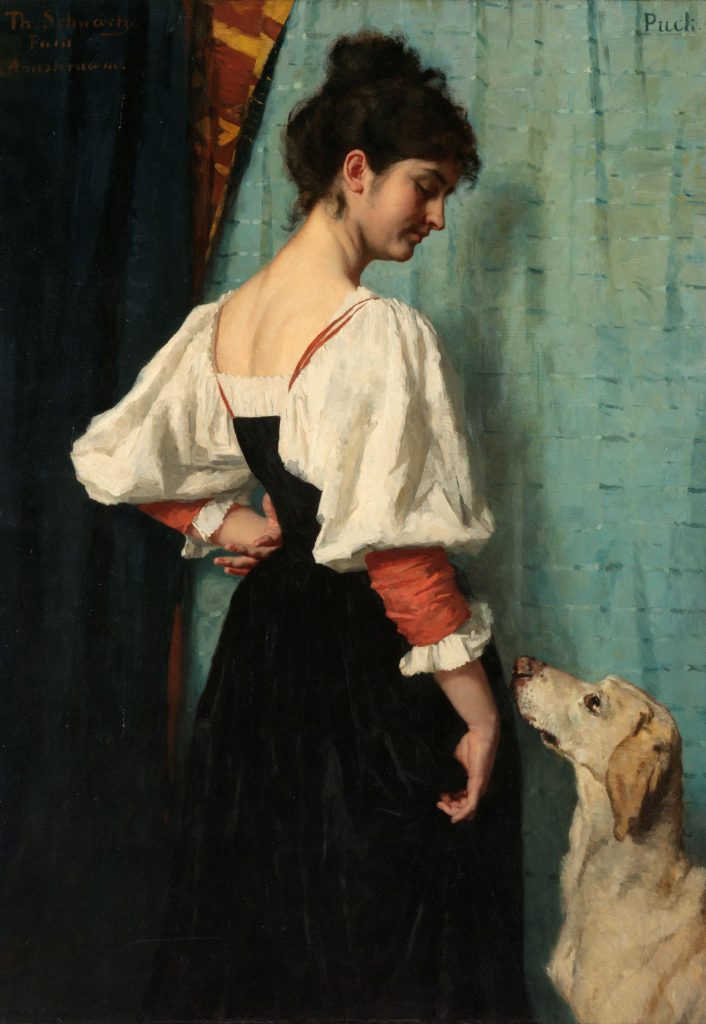
Thérèse Schwartze painted this model wearing Italian garb in her atelier in Paris. The young woman exchanges a glance with Puck, the dog at her right. The various rich fabrics of her dress are masterfully rendered. At the time, for a young Dutch woman to work in Paris was as unconventional as pursuing an artistic career. However, as the seasoned daughter of a professional painter, Schwartze was not deterred by such obstacles.
Rijksmuseum
What I love most about this hairstyle is how normal and modern it looks. This simple, messy top knot is how so many women wear their hair nowadays, and this painting proves that a beautiful curly bun never goes out of style. It’s a timeless do that’s super simple to achieve and can be done in just seconds in the morning.
Portrait of Hortense de Beauharnais, Queen of Holland, Anne-Louis Girodet-Trioson, c. 1805 – c. 1809

Hortense was Napoleon’s stepdaughter. Through her marriage to Napoleon’s brother, Louis Napoleon, she became Queen of Holland in 1806. Their marriage was not a success, and Hortense found Holland a cold and gloomy place. She preferred to live with her sons at Napoleon’s court in Paris, where she had her portrait painted by Girodet, the leading artist of the day.
Rijksmuseum
As opposed to the seemingly natural curls in the previous portrait, here we have a beautiful example of hair that’s obviously curled. My guess is these curls were achieved by rolling the hair up in rags overnight, to achieve the super tight ringlets that were so popular at this time. Unfortunately we can’t see much of the back of the hairstyle, but the face framing bits do tell us a lot about how hair was styled back then.
Maria Mathilda Bingham with Two of her Children, Thomas Lawrence, c. 1810 – c. 1818

The English portraitist Thomas Lawrence was a master in this type of informal family tableau. In this portrait, the father, Henry Baring, is missing. Judging by the direction of the gaze of Maria Mathilda Bingham and her son, he must have stood on the left. Maria divorced her husband and then had the painting reduced on that side. Presumably this was done by the artist, who then painted a curtain to close off the composition.
Rijksmuseum
Ending the list with this painting that doesn’t really feature a hairstyle, but does show a wonderful intimate scene of a mother and her children. And again some beautifully curled face framing strands, of course.
There’s so much to be discovered when it comes to art and hairstyles. I ran a series on my channel years ago where I recreated hairstyles from paintings. It didn’t do well at the time unfortunately, but I really enjoyed making it and was able to kind of bring it back through Beauty Beacons. I might just try to recreate some of these, one day.



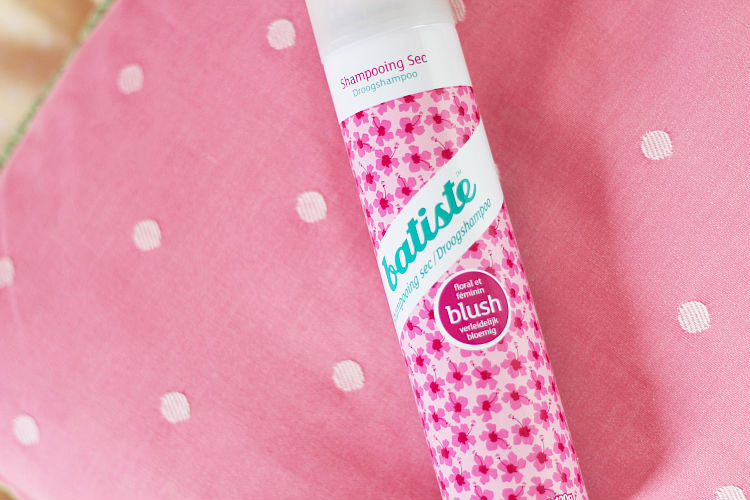


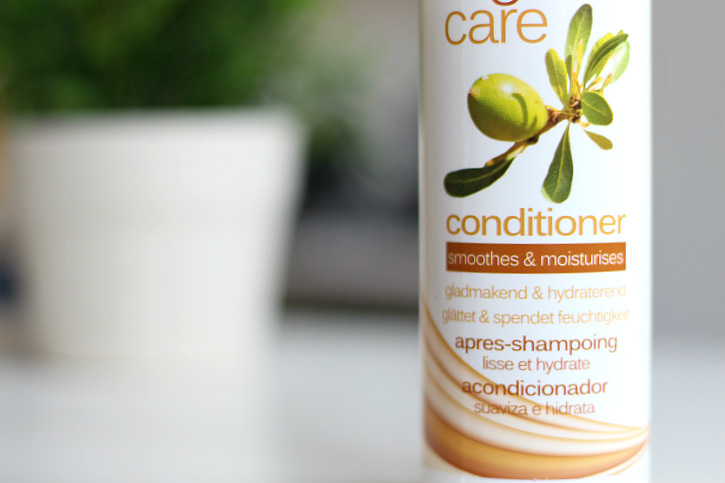
I remember your Art of hair series. Even though it didn’t do well, I really loved it. If I’m not mistaken, you did a recreation of the hairstyle in the Mary Magdalene painting by Crivelli.
This was such an interesting read! I visited the Rijksmuseum with my boyfriend last summer (we took a day trip to Amsterdam from Antwerp, but it was during that July heatwave, so it was over 37 degrees outside..!) and we absolutely loved it. There was SO much beautiful art to see. I’d love to go back sometime, as I think we only saw about half of the museum in the several hours that we were there.
Ohh I know! I started out really slowly, looking at each painting in detail but after a while I started to just run through all the rooms looking for female portraits as I felt like my back was about to break from all the standing around 😂 Will definitely have to go back soon!